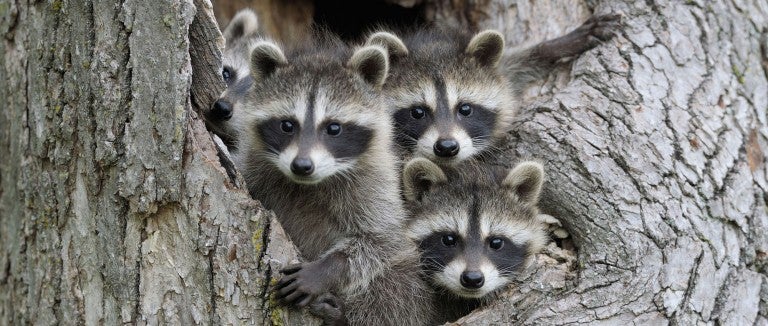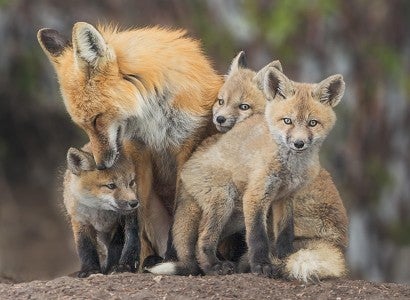Wherever you are in the U.S., a coyote may be taking up residence less than a mile away. If you live in the city, you’re more likely than your rural cousins to encounter raccoons. And regardless of geography, you probably share your home with dozens of species of insects and spiders.
These facts aren’t meant to scare you, though they’re often exploited by pest control companies for exactly that purpose. Proximity to wildlife should be cause for celebration—reminders that, no matter how many walls and fences we construct, we’re an integral part of the natural world.
Yet instead of awe and wonder, fear is our default reaction, often leading to trapping, poisoning, or, in the case of small creatures, the angry stomp of a shoe. In a society where federal scientists declared a century ago that predators “no longer have a place in our advancing civilization” and modern consumers can purchase weapons of mass habitat destruction at local hardware stores, our conflicted relationships with wild animals aren’t surprising. Many of us grew up in denuded landscapes without large carnivores or herbivores, from wolves to deer, and without context for how to coexist.
It’s OK to be afraid of spiders, but it’s not OK to kill the spider because you’re afraid of it.
Kerry Wixted, Maryland Department of Natural Resources
“More people could probably tell you about an African lion or an elephant than they could about a mountain lion or a gray fox—something native right here,” says Christine Barton, director of operations for the Fund for Animals Wildlife Center in Ramona, California, a care center operated by HSUS affiliate the Fund for Animals.
Caught in the crossfire of our contradictory attitudes are living beings with no real home to call their own. On private property, we treat wildlife as intruders, alerting police when coyotes wander the neighborhood. On public lands, we ourselves are the intruders, taking selfies with seals and cuddling up to buffaloes.
Healthy fears can be lifesaving—a lesson learned too late by tourists who treat wildlife as objects of entertainment. But fear doesn’t have to turn into loathing. “It’s OK to be afraid of spiders,” says Kerry Wixted of the Maryland Department of Natural Resources, “but it’s not OK to kill the spider because you’re afraid of it.”
It takes energy for spiders to bite or skunks to spray, and opossums don’t attack. Most bee and wasp species never sting, and many snakes present no threat. Yet viral videos about single incidents can spark outsized fears of entire classes of wildlife.
Instead of annihilating perceived dangers, we have an ethical responsibility to question cultural myths, keeping in mind a few key principles when learning about wildlife among us.
A humane backyard is a natural habitat offering wildlife plenty of food, water and cover, plus a safe place to live free from pesticides, chemicals, free-roaming pets, inhumane practices and other threats. And it's so easy to build!

It takes energy for spiders to bite or skunks to spray, and opossums don’t attack. Most bee and wasp species never sting, and many snakes present no threat.
Their motivations are survival-based
When animals get too close for comfort, it often means they’re hungry, thirsty, or protecting their young.
Bobcats and mountain lions venture near homes looking for water, says Barton, especially during wildfires that force them farther into human territories. Snakes inhabit porch mailboxes to eat insects attracted to lights; going dark encourages them to move along. Raccoon mothers who rip through plywood or other repairs to a hole in a wall are “not plotting to come down one day and kill you and your children,” says Toussaint. But if these DIY coverings have inadvertently trapped kits inside, they’ll “brave fire—they will brave darn near anything to get back to their children.” Toussaint advises callers to remove makeshift barriers and wait 24 hours; wild moms feeling unsafe will relocate kits to alternate den sites. (It’s best to work with a humane service to gently exclude wildlife before you get to this point.)
They all have jobs to do
Wixted has been stung enough in the past to be wary of yellow jackets. But she appreciates their dedication to their young and their role as wild garden helpers who gather insects for their nests.
When a nest expanded so quickly she worried neighborhood boys might come too close, another wild garden helper stepped in to take care of it. “That weekend, a raccoon dug it all up and ate everybody,” Wixted says. It’s a lesson she often teaches: Let stink bugs stay; spiders will eat them. Let spiders stay; hummingbirds will snatch them up. And so on, until everyone has had their fill in an elaborate web of life that, with just a little knowledge, we can all learn to appreciate.
Want more content like this?
This was written and produced by the team behind All Animals, our award-winning magazine. Each issue is packed with inspiring stories about how we are changing the world for animals together.
Learn MoreSubscribe

